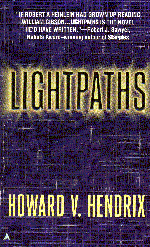|
Lightpaths
Copyright 1997 by
I first read this in August 1998. It's the near future and at last there's a real, commercial space station - the Orbital Complex - in orbit. The Orbital mixes pure research and commercial manufacturing, and it's doing very well and is close to achieving self-sufficiency. Earth-based military-industrial complexes have always seen the high-ground as a place of power, and the Orbital is, without question, very high ground. Thus they have been careful to avoid any possibility of the Orbital becoming a military presence, carefully screening all potential inhabitants to ensure only the truly non-violent are chosen. This has resulted, albeit accidentally, in a truly cooperative, compassionate and forward-thinking society, very different to that on Earth. Everything has been going rather well on the station, but now some odd things are happening. Large numbers of small satellites are being manufactured with no apparent purpose and with no authorisation. Computer viruses have contaminating several important systems. Some expert systems seem to have taken over the main network, and furthermore are building a very odd sculpture in one of the labs. Roger Cortland is the son of the Orbital's primary founder, but loathes the wet liberal Utopian ideals that Orbital society has adopted. Still as a scientist researching mole-rats, and with the Orbital just happens to have the largest mole-rat colony, he has to be there. Travelling to the Orbital for their first time are Jhana Meniskos and Marissa Corea, both scientists and both to become involved, for better or worse, with Roger and with the strange events beginning to unfold on the Orbital. One imagines the Earth of the future as a cyberpunk novelist's delight. But in this book, our heroes are those successful scientists who haven't dropped out. And instead of the hard-edged anarchism of the classic cyberpunk, this society is socialist and compassionate. It's good, one will keep reading because it's got some interesting plot-lines and it's clear that things could get very exciting. But book isn't just action, there's a great deal of sociological discussion and the possibility and desirability of Utopian societies. This isn't so bad, except that there is so much of it. You can't exactly have an edge-of-the-seat, riveting read if you're slogging through page after page discussing whether the word Utopia would be better spelled Eutopia. Loaded on the 7th June 2001.
|
|





